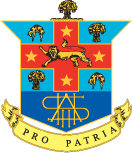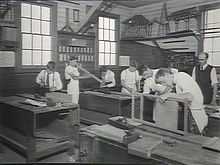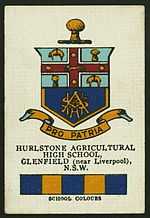Hurlstone Agricultural High School
| Hurlstone Agricultural High School | |
|---|---|
 Latin: Pro Patria For My Country | |
| Location | |
|
Glenfield, New South Wales Australia | |
| Coordinates | 33°58′14″S 150°53′29″E / 33.97056°S 150.89139°ECoordinates: 33°58′14″S 150°53′29″E / 33.97056°S 150.89139°E |
| Information | |
| Type | Public, Co-educational, Selective, Day and Boarding |
| Established | 1 April 1907 |
| Founder | John Kinloch |
| Principal | Daryl Currie |
| Grades | 7-12 |
| Enrolment | 985 (As of 2013) |
| Campus | 112 hectares (1.12 km²) |
| Colour(s) |
Blue, Red and Gold |
| Website | hurlstone.com.au |
Hurlstone Agricultural High School (abbreviated HAHS) is an agricultural, selective, co-educational, public high school located in Glenfield, a south-western suburb of Sydney, New South Wales, Australia. It is the oldest government boarding school in New South Wales (NSW).[1]
Hurlstone is unique in that it is the state's only public selective and agricultural school that also includes a coeducational boarding school. The 112 hectare campus includes an operational farm, sporting facilities and student accommodation.[2]
Hurlstone has been named the Macarthur region's best academic school, ranking 11th in the NSW top 200 list for the 2012 academic year. The school had 148 distinguished achievers, 13 on the state's top achievers' list, eight on the all-rounders' list and three students who topped the state in a course.
History

Hurlstone was established as a boys-only school in 1907 in Hurlstone Park, approximately ten kilometres south west of Sydney, at the present site of Trinity Grammar School. The original owner of the land was a teacher, John Kinloch, one of the first graduates of the University of Sydney. He named the land 'Hurlstone Estate', after his mother's maiden name, with the aim of setting up his own school on it.[3]
In those days most students completed their schooling after primary school and students at 'Hurlstone Agricultural Continuation School' (as it was known at the time) studied there for only two years. In 1926 the school moved to its present site in Glenfield, approximately 42 km south-west of Sydney (between Liverpool and Campbelltown) and adjacent to Glenfield railway station. By then its student numbers had grown from 30 in 1907, to 148.[3] The school supported government policy to promote productivity in the agricultural sector through the training of boys in all aspects of agricultural sciences and farm management.
For a brief period in the 1940s it was known as 'Macarthur Agricultural High School' in honour of wool-grower John Macarthur, but it soon reverted to its previous name.
Hurlstone was a boys' school until 1979, when the decision was made to become co-educational.[3]
On the 11th of December 2014, the school was evacuated after a boarding student was declared missing. Police were called to the school at 11 am. The student has since been found.
Principals

Hurlstone has had 12 Principals:
| Name | From | To |
|---|---|---|
| Frank McMullen | 1907 | 1916 |
| George Longmuir | 1917 | 1938 |
| Percival Hindmarsh | 1939 | 1945 |
| James McEwan King | 1946 | 1953 |
| Clarence G. James | 1954 | 1967 |
| Reginald W. Clarke | 1968 | 1978 |
| James F. White | 1979 | 1982 |
| G. K. Wilson | 1983 | 1987 |
| R. M. Kidd | 1988 | 2003 |
| John Norris | 2003 | 2010 |
| Kerrie Wratten | 2011 | 2013 |
| Daryl Currie | 2014 | Present [4] |
Population

Enrolment at the school is dependent on selective examinations of Year 6 students from across the state. New students coming in later grades have to sit a similar exam. [5]
The student population of about 975 is divided between boarder students (who reside on the school grounds and originate mainly from country NSW), and day students (who commute mostly from the south western Sydney region). The boarder-day student ratio is roughly 1:8. For sporting and accommodation purposes the school is divided into four houses: Farrer (red), Macarthur (yellow), Wentworth (blue) and Macquarie (green).
Campus

Hurlstone Agricultural High School is located on a single campus, covering the area from Glenfield railway station, along Roy Watts Road and extending to sections of Quarter Sessions Road near the Hume Highway. The station is serviced by the Airport, Inner West & South Line and the Cumberland Line.
The school has several enclaves, including the Department of Education regional office and the Department of Public Works office. It also has several special schools, Ajuga Primary School, Glenfield Park School and Campbell House High School. Ajuga and Campbell House are for students expelled from other schools while Glenfield Park is for students with a disability.
Hurlstone features a fully functional farm and a commercial dairy. Livestock on the farm include: Beef and dairy cattle, sheep, horses, pigs, chickens, ducks, Boer goats and bees.[6] Alpacas and peacocks were also formerly farmed.
The school's swimming pool is located adjacent to the boarding school, and was used for swimming carnivals, school sports and recreational purposes. Towards the end of 2012, the pool was closed down due to hygiene issues. Plans to rebuild the pool have been considered but no construction has started.
Clarke House is a heritage listed building which houses Hurlstone's memorabilia museum. [7]
On Roy Watts Road past the boarding school there is a memorial forest with trees planted in the shape of a cross. The memorial forest is where the Anzac Day and Remembrance day ceremonies are held.
As part of the 2008 mini-budget, the New South Wales Government declared 140 hectares of the school to be surplus to educational needs and the land will be sold in 2011.[8] However, due to a strong public protest against this action,[9] an inquiry was led into process of selling approximately seven eighths of the school.[10] As a result, Mal Peters, the Inquiry Chair, recommended the school's agricultural sector to be upgraded in order to reflect current industry practice and standards due to it being an economic, wise and important public investment for the people of NSW as it supplies young scientists with the knowledge for the ever declining, but demanding agricultural sector of the world.[11]
Extracurricular activities
The school provides opportunities for students to engage in both co-curricular and extracurricular activities. Students may participate in certain clubs which promote these activities. Some groups are fairly unique to public schools within the district, such as the Cadet corps, Interact and Rural Youth. Hurlstone's Interact Club is the largest student run Interact in the Southern Hemisphere. Sport is an important part of extracurricular life at Hurlstone. Hurlstone also participates in the Law Society of NSW's Mock Trial competition. The 2011 team came 2nd in the competition.
Other extracurricular activities at the school include the HCF (Hurlstone Christian Fellowship), School SRC, Environment Committee, Debating, Boarder Council, Pops Orchestra and EPIC (Entertainment and Performing Arts Integrated Community). These groups help to improve the school in a number of ways from the environment to the entertainment sector.
Notable alumni
- Academic
- Dr Lester Hiatt - Visiting Professor of Australian Studies at Harvard 1990-91;[12]
- Professor Ross Street - Personal Chair in Mathematics at Macquarie University;
- Peter Moxham, Principal of Kambala School (1988-99); [13]
- Gareth White - featured on Nerds FC series 2 and represented Australia in the 2002 International Mathematics Olympiad
- Ishraq Ahmed - Represented Australia in 2010 in the Asian Physics Olympiad.
- Tim Soutphommasane - Research Fellow in the National Centre of Australian Studies at Monash University in Melbourne and a senior project leader with the Per Capita think tank
- Giles Gardam - Represented Australia at the 2008 International Mathematics Olympiad in Madrid, Spain - achieving a silver medal.[14][15]
- Jonathan Kusilek - Represented Australia in 1997 at the International Mathematics Olympiad.
- Patrick El-Hayek - All Rounders List 2010 [16]
- Dr Alan O. Trounson (1958 - 1962)- Biologist, stem cell researcher and IVF pioneer.[17]
- Business
- Geoffrey Stooke OAM, Managing Director of Standard Wool Australia, Chairman of RugbyWA;[18]
- Entertainment, community, media and the arts
- Toby Allen - Singer for band Human Nature
- Phil Burton - Singer for band Human Nature
- Michael Tierney - Singer for band Human Nature
- Andrew Tierney - Singer for band Human Nature
- Ania Stepien - Actress on Cybergirl
- Peter Moore - Author
- Dan O'Connor - Top 12 of 2004 Australian Idol and actor
- Kate Ritchie - Actress and Radio Personality
- Margaret Tierney - Former Miss Australia (1995)
- Subby Valentine - Comedian
- Jordan Kerr - Director of the National Youth Council of Australia
- Matt Hall - Beauty and the Geek Australia 2012 contestant
- Military
- Mark Binskin [19] - Chief of the Defence Force (CDF) Australia.
- John Hurst Edmondson VC - Soldier in World War II; the Hurlstone school hall is named in his honour[20]
- Sir William Keys Kt AC MC - National Secretary of RSL[21]
- Andrew Sims - Brigadier General, served in Pakistan and East Timor
- Allen Lo - Recruit at University of New South Wales, Australian Defence Force Academy, Canberra
- Politics, public service and the law
- John Kerin - Politician, former Treasurer of Australia
- Dr Dick Klugman, Member for federal seat of Prospect 1969 - 1990, Co-founder of NSW Council for Civil Liberties;[22]
- Mark Latham - Politician, former Leader of the Australian Labor Party[23]
- Jim Lees - Former Commissioner of the New South Wales Police
- Roy Watts, AO - Former Director-General NSW Agriculture (School's main road named after him).
- Clinton Mead - Politician, Mayor of Campbelltown, New South Wales.
- Sport
- David Lyons - rugby union player, Wallabies[24]
- John Taylor - rugby union player, Wallabies
- Melanie Wells - Hockey player and the co-captain of Olympic team, Hockeyroos
- Paul Reid - football player, Socceroos
- Scott Kneller - Freestyle Skier and competed in the 2010 Vancouver Winter Olympics
- Cec Ramalli - Wallaby [25]
- Agriculture
- David Lowe - Winemaker & owner, Lowe Wines, President NSW Wine Industry, Vice President Australian Winemakers Federation
- Charles Melton - Winemaker.[26]
See also
- List of Government schools in New South Wales
- List of selective high schools in New South Wales
- List of boarding schools
- List of Victoria Crosses by School
- James Ruse Agricultural High School
References
- ↑ Patty, Anna (29 September 2007). "Parents demand answers over top school's finances". Sydney Morning Herald.
- ↑ https://www.google.com.au/maps/place/Hurlstone+Agricultural+High+School/@-33.968491,150.885652,693m/data=!3m2!1e3!4b1!4m2!3m1!1s0x6b1294cae8e47a9d:0xee133fdeb37a1f82
- ↑ 3.0 3.1 3.2 Hurlstone Agricultural High School. School History
- ↑ http://www.hurlstone.com.au/
- ↑ Enrolment section of: http://www.hurlstone.com.au/
- ↑ Farm section of: http://www.hurlstone.com.au/
- ↑ https://secure.flickr.com/photos/37523188@N00/646528871/
- ↑ NSW Government Mini-Budget - Andrew Stoner
- ↑
- ↑
- ↑
- ↑ p. 727 Who's Who in Australia 1995
- ↑ http://www.zoominfo.com/p/Peter-Ba/637060224
- ↑ Dikeos, Thea (8 July 2008). Aussie mathletes head to Madrid ABC Interview.
- ↑ SORAIYA GHARAHKHANI (6 August 2008). How it all adds up Macarthur Advertiser.
- ↑ http://www.boardofstudies.nsw.edu.au/ebos/static/ALRND_2010_12.html
- ↑ p. 45 Hurlstone Inquiry.
- ↑ Who's Who in Australia 2011 page 2034
- ↑ Flying high - Local News - News - General - Campbelltown - Macarthur Advertiser
- ↑ Grant, Ian (1996). "Edmondson, John Hurst (1914 - 1941)". Australian Dictionary of Biography 14 (Online ed.). Melbourne: Melbourne University Press. p. 80. Retrieved 2008-01-23.
- ↑ p. 619 Who's Who in Australia 1977
- ↑ Obituary in Sydney Morning Herald 14 March 2011
- ↑ Burke, Kelly (2004-02-10). "One of the old school". TV & Radio (The Age). Retrieved 2008-02-20.
- ↑ Patty, Anna (26 May 2006). From the principal's desk: furniture sale means I've been carpeted Sydney Morning Herald.
- ↑ http://books.google.com.au/books?id=1nk2Vcl2jGQC&pg=PA30&dq=blow+ide+north+sydney+school&hl=en&sa=X&ei=LaZlT7jHKuTMmAXWstmVCA&ved=0CDcQ6AEwAA#v=onepage&q=blow%20ide%20north%20sydney%20school&f=false
- ↑ "Charles Melton". Barons of the Barossa. 2007-10-20. Retrieved 2011-09-21.
External links
- Hurlstone Agricultural High School website
- Hurlstone Agricultural High School Alumni website
- NSW Department of Education and Training: Hurlstone Agricultural High School